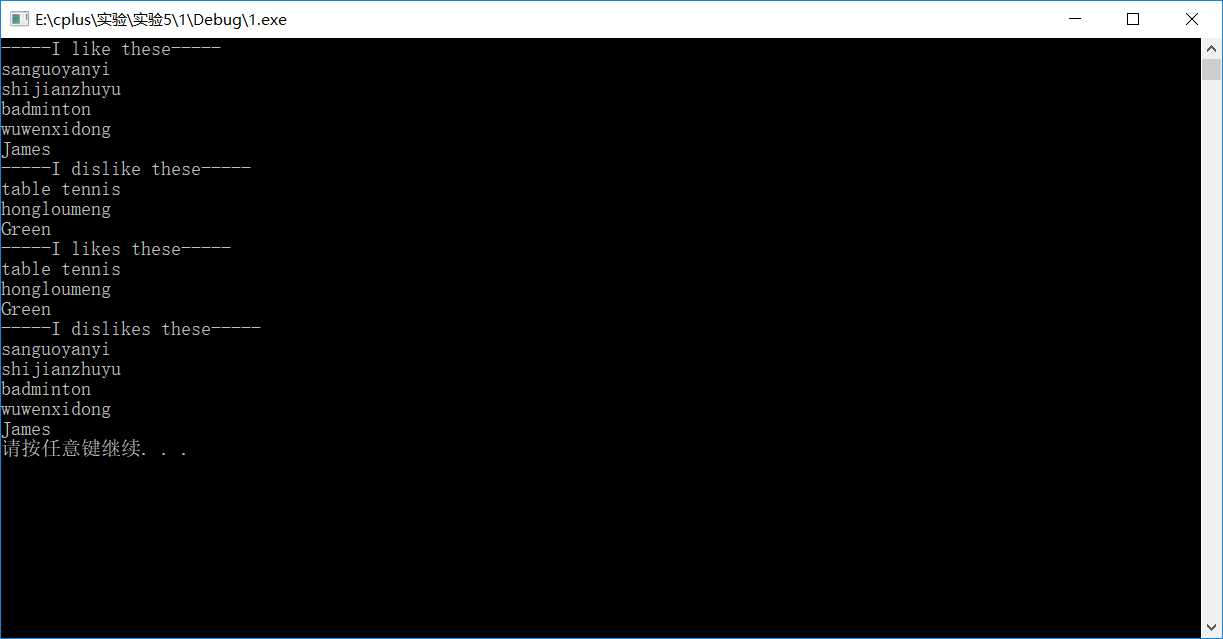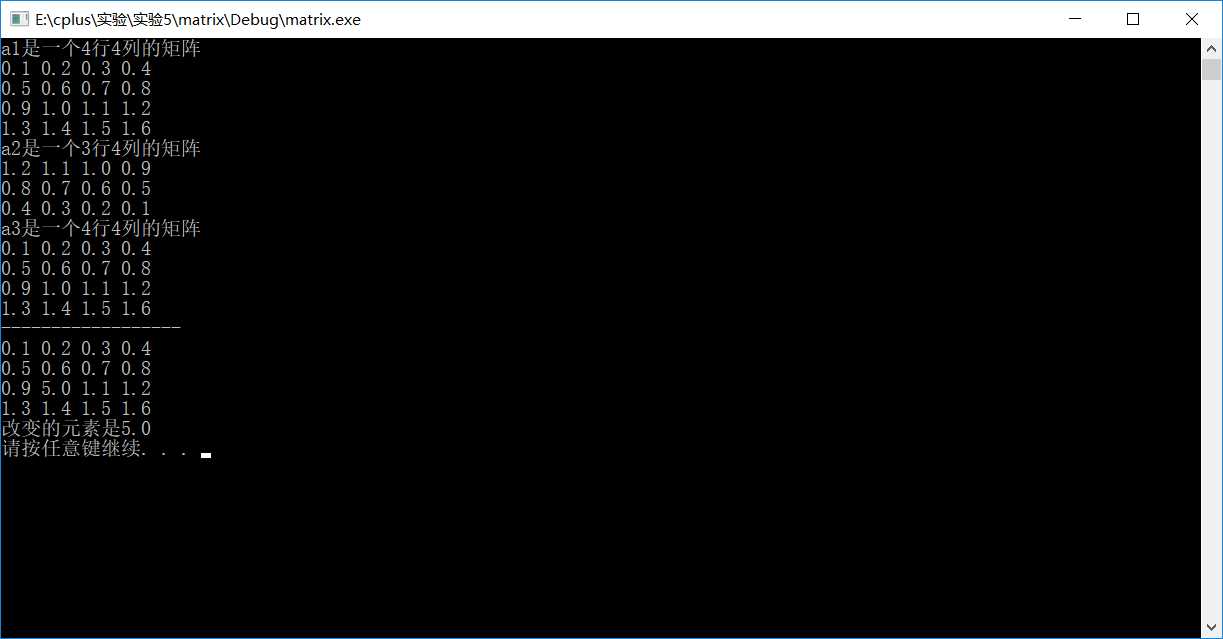实验五
Posted zhaoluolong
tags:
篇首语:本文由小常识网(cha138.com)小编为大家整理,主要介绍了实验五相关的知识,希望对你有一定的参考价值。
ex3:
#include <iostream> #include <vector> #include <string> using namespace std; // 函数声明 void output1(vector<string> &); void output2(vector<string> &); int main() { vector<string>likes, dislikes; // 创建vector<string>对象likes和dislikes likes.push_back("sanguoyanyi"); likes.push_back("shijianzhuyu"); likes.push_back("badminton"); likes.push_back("wuwenxidong"); likes.push_back("James"); // 为vector<string>数组对象likes添加元素值 ( favorite book, music, film, paintings,anime,sport,sportsman,etc) // 补足代码 // 。。。 cout << "-----I like these-----" << endl; output1(likes); // 调用子函数输出vector<string>数组对象likes的元素值 // 补足代码 // 。。。 dislikes.push_back("table tennis"); dislikes.push_back("hongloumeng"); dislikes.push_back("Green"); // 为vector<string>数组对象dislikes添加元素值 // 补足代码 // 。。。 cout << "-----I dislike these-----" << endl; output1(dislikes); // 调用子函数输出vector<string>数组对象dislikes的元素值 // 补足代码 // 。。。 swap(likes, dislikes); // 交换vector<string>对象likes和dislikes的元素值 // 补足代码 // 。。。 cout << "-----I likes these-----" << endl; output2(likes); // 调用子函数输出vector<string>数组对象likes的元素值 // 补足代码 // 。。。 cout << "-----I dislikes these-----" << endl; output2(dislikes); // 调用子函数输出vector<string>数组对象dislikes的元素值 // 补足代码 // 。。。 system("pause"); return 0; } // 函数实现 // 以下标方式输出vector<string>数组对象v的元素值 void output1(vector<string> &v) { for (int i = 0; i < v.size(); i++) cout << v[i] << endl; // 补足程序 // 。。。 } // 函数实现 // 以迭代器方式输出vector<string>数组对象v的元素值 void output2(vector<string> &v) { vector <string>::iterator it; for (auto e : v) cout << e << endl; // 补足程序 // 。。。 }

6-17:
#include<iostream> using namespace std; int main() { int *p; //未给指针p初始化,使得p指向未知区域,编译不成功 *p = 9; cout << "The value at p:" << *p; system("pause"); return 0; }
修正:
#include<iostream> using namespace std; int main() { int p1; int *p = &p1; //初始化p指向p1 *p = 9; cout << "The value at p:" << *p << endl; //可以不换行的 system("pause"); return 0; }

6-18:
#include<iostream> using namespace std; int fnl() { int *p = new int(5); return *p; //未delete动态申请的空间 } int main() { int a = fnl(); cout << "the value of a is: " << a; system("pause"); return 0; }
修正:
#include<iostream> using namespace std; int p1; int *p = &p1; //利用全局变量,以便delete int fnl() { p = new int(5); return *p; } int main() { int a = fnl(); cout << "the value of a is: " << a << endl;
delete p; //delete动态申请的空间 system("pause"); return 0; }

matrix:
matrix.h
#pragma once #ifndef MATRIX_H #define MATRIX_H class Matrix { public: Matrix(int n); // 构造函数,构造一个n*n的矩阵 Matrix(int n, int m); // 构造函数,构造一个n*m的矩阵 Matrix(const Matrix &X); // 复制构造函数,使用已有的矩阵X构造 ~Matrix(); //析构函数 void setMatrix(const float *pvalue); // 矩阵赋初值,用pvalue指向的内存块数据为矩阵赋值 void printMatrix() const; // 显示矩阵 inline float &element(int i, int j) //返回矩阵第i行第j列元素的引用 { float& n = p[i*cols + j]; return n; } inline float element(int i, int j) const // 返回矩阵第i行第j列元素的值 inline函数在类内定义 { return p[i*cols + j]; } void setElement(int i, int j, int value); //设置矩阵第i行第j列元素值为value inline int getLines() const //返回矩阵行数 { return lines; } inline int getCols() const //返回矩阵列数 { return cols; } private: int lines; // 矩阵行数 int cols; // 矩阵列数 float *p; // 指向存放矩阵数据的内存块的首地址 }; #endif
matrix.cpp
#include<iostream> #include<iomanip> #include"matrix.h" using namespace std; Matrix::Matrix(int n) :lines(n), cols(n) { p = new float[lines*cols]; } Matrix::Matrix(int n, int m) : lines(n), cols(m) { p = new float[lines*cols]; } Matrix::Matrix(const Matrix &X) : lines(X.lines), cols(X.cols) { p = new float[lines*cols]; for (int i = 0; i < X.lines*X.cols; i++) { *(p + i) = *(X.p + i); } } Matrix::~Matrix() { delete[] p; } void Matrix::setMatrix(const float *pvalue) { for (int i = 0; i < lines*cols; i++) *(p + i) = *(pvalue + i); } void Matrix::printMatrix() const { for (int i = 0; i < lines; i++) { for (int j = 0; j < cols; j++) cout << setiosflags(ios::fixed) << setprecision(1) << p[i*cols + j] << ‘ ‘; cout << endl; } } void Matrix::setElement(int i, int j, int value) { p[i*cols + j] = (float)value; }
main.cpp
#include<iostream> #include<iomanip> #include"matrix.h" using namespace std; int main() { Matrix a1(4); Matrix a2(3, 4); float b1[16], b2[12]; for (int i = 1; i <= 16; i++) b1[i-1] = (float)i / (float)10; for (int i = 0; i < 12; i++) b2[i] = (float)(12 - i) / (float)10; float *p1 = b1; float *p2 = b2; a1.setMatrix(p1); cout << "a1是一个" << a1.getLines() << "行" << a1.getCols() << "列的矩阵" << endl; a1.printMatrix(); a2.setMatrix(p2); cout << "a2是一个" << a2.getLines() << "行" << a2.getCols() << "列的矩阵" << endl; a2.printMatrix(); Matrix a3(a1); cout << "a3是一个" << a3.getLines() << "行" << a3.getCols() << "列的矩阵" << endl; a3.printMatrix(); cout << "------------------" << endl; a3.setElement(2, 1, 5); a3.printMatrix(); cout << "改变的元素是" << a3.element(2, 1) << endl; system("pause"); return 0; }

期中考试
http://www.cnblogs.com/zhaoluolong/p/9015694.html
以上是关于实验五的主要内容,如果未能解决你的问题,请参考以下文章